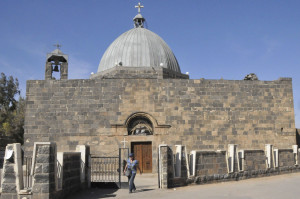
Church of St. George in Ezra, Syria (Photo by Don Knebel)
Ezra lies about 50 miles south of Damascus along the western edge of the Hauran, a fertile plateau that played a role in the early development of agriculture. Today, Ezra is best known for its domed Church of St. George. The square building.is made of basaltic rock and includes two inscribed octagonal structures, the inner one supporting the dome. An inscription between two crosses over the door says the Greek Orthodox Church was erected in 515 A.D. on the site of a pagan temple. Except for a nineteenth century reconstruction of its damaged dome, the building remains essentially unchanged since its erection.
Colorful icons and gold vigil lamps adorn the sanctuary, but the church’s most prized possession is a box, draped with a rich red cloth, resting behind the altar. A stone plaque leaning against the base of the box bears the iconic image of St. George killing a dragon. The inscription above the entrance says the church was built to house the remains of St. George and church members believe remains of the martyred St. George are in the box. How much remains of him is not so clear. A sarcophagus in the Church of St. George in Lod (Lydda), Israel, considered the birthplace of St. George, is said to hold his body. His head has been claimed by churches in both Greece and Italy.
The Ezra church has a distinction none of the other sites claiming St. George’s remains can match – it is one of the oldest continuously functioning church buildings in the world. Some attribute the church’s long survival to the admiration Syrian Muslims also have for St. George, the patron saint of not only England and Georgia but Palestine and Egypt. Members of Ezra’s Church of St. George look instead to their draped box, topped with tokens of gratitude. For them, St. George, whose feast day is April 23, has protected this ancient house of worship.
Comments are closed.